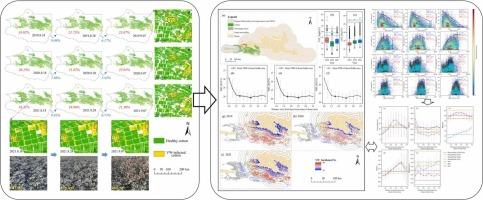Industrial Crops and Products ( IF 5.6 ) Pub Date : 2024-06-28 , DOI: 10.1016/j.indcrop.2024.119063 Yaohui Gui , Changping Huang , Junru Zhou , Ze Zhang , Jin Wang , Xiaoyan Kang , Wenjiang Huang , Xin Lv , Lifu Zhang

|
Verticillium wilt (VW) is threatening global cotton yield and quality. However, the accurate spatio-temporal dynamics of cotton VW in large regions remain unclear, especially in the complicated oasis agriculture ecosystem. We explored the spatio-temporal distribution of VW in the cotton-dominated region of Northern Xinjiang characterized by a typical desert-oasis irrigation agriculture ecosystem, utilizing reconstructed high-resolution time series remote sensing data from 2019 to 2021. Results revealed that the area of VW-infected cotton remained consistently around 20 % each year. However, there were significant seasonal variations, with outbreaks peaking in August. Regarding the spatial pattern of cotton VW, the mean temperature (TMP) difference in irrigated cotton fields along the Gurbantunggut Desert-oasis gradient reaches a maximum of approximately 1 ℃ caused by warming effect of the desert on the oasis (WEDO) during the cotton growing period. This TMP difference drives the spatial pattern of cotton VW incidence characterized by a low-to-high-to-moderate trend. WEDO significantly suppresses the cotton VW incidence due to relatively higher TMP, forming the low-risk zone for cotton VW within 16 km near the Gurbantunggut Desert. Our study significantly enhances the understanding of the spatio-temporal dynamics of cotton VW in the distinctive oasis irrigation agricultural ecosystem and advances the accurate monitoring and assessment of cotton VW across large regions.
中文翻译:

沙漠变暖效应调节绿洲农业生态系统棉花黄萎病时空分布
黄萎病 (VW) 正在威胁全球棉花产量和质量。然而,大区域棉花大众的准确时空动态仍不清楚,特别是在复杂的绿洲农业生态系统中。利用2019—2021年重建的高分辨率时间序列遥感数据,探讨了以典型荒漠-绿洲灌溉农业生态系统为特征的北疆棉花为主区VW的时空分布。每年受 VW 感染的棉花始终保持在 20% 左右。然而,季节性变化显着,八月份疫情达到顶峰。从棉花VW的空间格局来看,由于棉花生长过程中沙漠对绿洲的增温效应(WEDO),古尔班通古特沙漠-绿洲梯度沿线的灌溉棉田平均温度(TMP)差异达到最大值约1℃。时期。这种 TMP 差异驱动了棉花 VW 发病率的空间格局,其特征是从低到高到中等趋势。 WEDO由于TMP相对较高,显着抑制了棉花VW的发生,在古尔班通古特沙漠附近16公里范围内形成了棉花VW的低风险区。我们的研究显着增强了对独特绿洲灌溉农业生态系统中棉花VW时空动态的理解,并推进了大区域棉花VW的准确监测和评估。











































 京公网安备 11010802027423号
京公网安备 11010802027423号